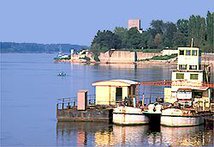Border: Bulgaria-Romania
Date(s) of establishment: 1878; current demarcation in 1940Length of border: 631 km
Regions concerned: Counties of Mehedinți, Dolj, Olt, Teleorman, Giurgiu, Călărași et Constanța (Romania)
Provinces of Vidin, Montana, Vratsa, Pleven, Veliko Tarnovo, Ruse, Silistra et Dobrich (Bulgaria)
European programme(s):
- Interreg IV A "Bulgaria-Roumania":
The programme on the Inforegio website - Interreg IV B "South East Europe":
Website of the programme
The Romanian-Bulgarian border stretches over 609 km, of which around 470 km are formed by the river Danube. The border begins in the east at the tripoint formed with the Serbian border, near the town of Bregovo in Bulgaria, and follows the river as far as the cities of Silistra (Bulgaria) and Călărași (Romania). Beyond this point, the border becomes terrestrial until it reaches the Black Sea between the towns of Shabla (Bulgaria) and Mangalia (Romania).Along this border there are 14 crossing points – seven by boat, five by road and 2 by rail. The first Bulgarian-Romanian bridge over the Danube between the cities Ruse (Bulgaria) and Giurgiu (Romania) was opened in 1954. A second bridge was opened in 2013, between Vidin (Bulgaria) and Calafat (Romania).
History
Following the treaty of San Stefano and the Congress of Berlin in 1878, which brought to an end the Russo-Turkish War, Romania’s independence was recognised and the country received the northern part of the Dobrogea (Dobruja) region, the south of which remained under Ottoman control. The Congress of Berlin also created an autonomous Principality of Bulgaria within the Ottoman Empire, thus establishing the Romanian-Bulgarian border. The Principality of Bulgaria joined with the autonomous province of Eastern Rumelia in 1885, before becoming an independent state in 1908.
The new Bulgaria participated in the Balkan Wars of 1912-1913. Due to a decision of the Treaty of Bucharest in 1913, which brought to an end the second Balkan War, Bulgaria lost South Dobrogea to Romania, modifying the border. With Romania’s entry into the First World War on the side of the Allies, the Central Powers occupied the entire region of Dobrogea and in May 1918 returned South Dobrogea to Bulgaria along with a portion of Northern Dobrogea, under a new Bucharest treaty; the rest of the region remained under occupation. This situation proved short-lived as the treaty was nullified by the armistice of November 1918, before the Treaty of Neuilly-sur-Seine (1919) attributed the entire region to Romania, re-establishing the border of the 1913 Bucharest treaty.
During the Second World War, Bulgaria, allied with Germany, pressured to recover South Dobrogea, which it obtained in 1940 under the terms of the Craivoa Treaty, returning the border to its 1878 position.
This demarcation survived the era of the People’s Republic of Bulgaria and the Socialist Republic of Romania.
Following the fall of the communist regimes, in February 1992 the two countries signed a treaty of friendship, cooperation and good neighbourliness, in which they recognise the inviolability of their borders. It is thus the 1940 demarcation that is recognised today by the two countries, both members of the European Union since 2007.
Cross-border cooperation
The cross-border territory around the Romanian-Bulgarian border is not homogeneous and lacks a cross-border regional identity. However, a real potential for cross-border development exists, and cooperation is taking shape, little by little.
The first cross-border cooperation programmes were implemented between 1999 and 2006 with the support of the PHARE-CBC fund (IPA – Instrument for Pre-Accession Assistance). For the period 2007-2013, an Interreg operational programme, funded by the ERDF was set up, with a total budget of € 262 million. This programme covers the entire Romanian-Bulgarian border, and its general strategic objective is to bring people, communities and the economies of the border area closer together, and to support the two countries in the joint creation of a cooperation area. In order to achieve this goal, several priorities have been identified:
- Priority 1 - Accessibility and mobility: improve existing infrastructure and create new transport facilities to enable efficient and regular exchanges.
- Priority 2 - Environment: Sustained protection of the region’s natural resources and heritage, awareness-raising for protection of the environment in the cross-border area.
- Priority 3 - Economic and Social Development: develop cross-border commercial infrastructure and services, as well as cross-border tourism products. Also ensure the formation of partnerships between universities and between education and training centres.
The Romanian-Bulgarian cross-border area is also part of the “South East Europe” 2007-2013 programme, the programme for transnational cooperation in the Black Sea Basin, and the macro-regional strategy for the Danube region.
On the Romanian-Bulgarian border there are plans for an EGTC, between the towns of Silistra (BG) and Medgidia (RO), near the Black Sea.
The Vidin-Calafat bridge
For the purposes of strengthening road and rail connections between the two countries and promoting economic development at the local level, a second bridge between Romania and Bulgaria opened in summer 2013, the first between Ruse and Giurgiu, dating from 1954.
Over the years several options for the location of the second Bulgarian-Romanian Danube bridge were studied. In 2007 the construction of the bridge between Vidin (Bulgaria) and Calafat (Romania) began on the western part of the border between the two countries.
With a total budget of about 270 million euros (about 220 million for the Bulgarian side and 50 million for the Romanian side), co-financed by European funds, the bridge has encountered several delays.
This bridge with a length of approximately two kilometres is part of Pan-European Transport Corridor IV (Dresden/Nuremberg - Prague - Vienna - Bratislava - Györ - Budapest - Arad - Bucharest - Constanţa / Craiova - Sofia - Thessaloniki/Plovdiv - Istanbul).
Territory projects and institutional bodies for cooperation
Cross-border cooperation at the local level
Calafat-VidinRuse-Giurgiu


